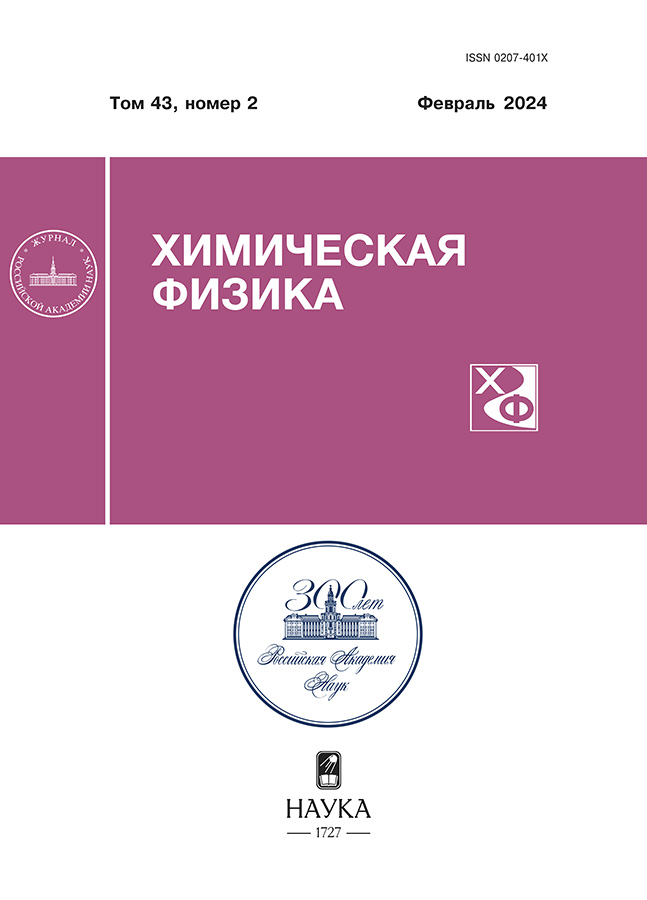Lipid-mediated effect of glycyrrhizin on the properties of the transmembrane domain of the E-protein of the SARS-CoV-2 virus
- Авторлар: Kononova P.A.1,2, Selyutina O.Y.1,3, Polyakov N.E.1,3
-
Мекемелер:
- Voevodsky Institute of Chemical Kinetics and Combustion, Russian Academy of Sciences, Siberian Branch of the Russian Academy of Sciences
- Novosibirsk State University
- Institute of Solid State Chemistry and Mechanochemistry, Siberian Branch of the Russian Academy of Sciences
- Шығарылым: Том 43, № 2 (2024)
- Беттер: 56-61
- Бөлім: Chemical physics of biological processes
- URL: https://rjraap.com/0207-401X/article/view/674986
- DOI: https://doi.org/10.31857/S0207401X24020065
- EDN: https://elibrary.ru/WHQXFH
- ID: 674986
Дәйексөз келтіру
Аннотация
The interaction of glycyrrhizin with the transmembrane domain of the E-protein of the SARS-CoV-2 virus (E-protein Trans-Membrane domain, ETM) in a homogeneous aqueous solution and in a model lipid membrane was studied using the selective nuclear Overhauser effect (selective NOESY) and NMR relaxation methods. The selective NOESY showed the presence of the interaction of glycyrrhizin with ETM in an aqueous solution, which is consistent with the literature modeling data, which indicate the possibility of penetration of the glycyrrhizin molecule into the channel formed by the ETM molecules. However, this conclusion is not confirmed by NOESY experiments in model lipid membranes, DMPC/DHPC bicelles. At the same time, the NMR relaxation method revealed the effect of glycyrrhizin on the mobility of both lipids and ETM molecules in bicelles. This suggests that GA affects the activity of the coronavirus E-protein indirectly through lipids.
Негізгі сөздер
Толық мәтін
Авторлар туралы
P. Kononova
Voevodsky Institute of Chemical Kinetics and Combustion, Russian Academy of Sciences, Siberian Branch of the Russian Academy of Sciences; Novosibirsk State University
Email: olga.gluschenko@gmail.com
Ресей, Novosibirsk; Novosibirsk
O. Selyutina
Voevodsky Institute of Chemical Kinetics and Combustion, Russian Academy of Sciences, Siberian Branch of the Russian Academy of Sciences; Institute of Solid State Chemistry and Mechanochemistry, Siberian Branch of the Russian Academy of Sciences
Хат алмасуға жауапты Автор.
Email: olga.gluschenko@gmail.com
Ресей, Novosibirsk; Novosibirsk
N. Polyakov
Voevodsky Institute of Chemical Kinetics and Combustion, Russian Academy of Sciences, Siberian Branch of the Russian Academy of Sciences; Institute of Solid State Chemistry and Mechanochemistry, Siberian Branch of the Russian Academy of Sciences
Email: olga.gluschenko@gmail.com
Ресей, Novosibirsk; Novosibirsk
Әдебиет тізімі
- Baglivo M., Baronio M., Natalini G. et al. // Acta Biomed. 2020. V. 91. № 1. P. 161.
- Tang T., Bidon M., Jaimes J.A., Whittaker G.R., Daniel S. // Antiviral Res. 2020. V. 178. P. 104792.
- Venkatagopalan P., Daskalova S.M., Lopez L.A., Dolezal K.A., Hogue B.G. // Virology. 2015. V. 478. P. 75.
- Schoeman D., Fielding B.C. // Virol. J. 2019. V. 16. № 1. P. 69.
- Mehregan A., Perez-Conesa S., Zhuang Y. et al. // Biochim. Biophys. Acta-Biomembr. 2022. V. 1864. № 10. P. 183994.
- Wilson L., Gage P., Ewart G. // Virology. 2006. V. 353. № 2. P. 294.
- Gupta M.K., Vemula S., Donde R. et al. // J. Biomol. Struct. Dyn. 2021. V. 39. № 7. P. 2617.
- Pervushin K., Tan E., Parthasarathy K. et al. // PLOS Pathog. 2009. V. 5. № 7. P. e1000511.
- Chernyshev A. Pre-print. 2020. https://doi.org/10.26434/chemrxiv.12286421.v110.
- G.A. Tolstikov, L.A. Baltina, V.P. Grankina et al. Novosibirsk. Geo Publishing (2007) (in russian).
- Shibata S. // Yakugaku Zasshi. 2000. V. 120. № 10. P. 849.
- Selyutina O.Y., Polyakov N.E. // Inten. J. Pharm. 2019. V. 559. P. 271.
- Fiore C., Eisenhut M., Krausse R. et al. // Phytother. Res. 2008. V. 22. № 2. P. 141.
- Sun Z.G., Zhao T.T., Lu N., Yang Y.A., Zhu H.L. // Mini Rev. Med. Chem. 2019. V. 19. № 10. P. 826.
- Pompei R., Pani A., Flore O., Marcialis M.A., Loddo B. // Experentia. 1980. V. 36. № 3. P. 304.
- Hoever G., Baltina L., Michaelis M. et al. // J. Med. Chem. 2005. V. 48. № 4. P. 1256.
- Chrzanowski J., Chrzanowska A., Graboń W. // Phyther. Res. 2021. V. 35. № 2. P. 629.
- Bailly C., Vergoten G. // Pharmacol. Ther. 2020. V. 214. P. 107618.
- Fomenko V.V., Rudometova N.B., Yarovaya O.I. et al. // Molecules. 2022. V. 27. № 1. P. 295.
- Kang H., Lieberman P.M. // J. Virol. 2011. V. 85. № 21. P. 11159.
- Sekizawa T., Yanagi K., Itoyama Y. // Acta Virol. 2001. P. 51.
- Baba M., Shigeta S. // Antiviral Res. 1987. V. 7. № 2. P. 99.
- Lin J.C. // Ibid. 2003. V. 59. № 1. P. 41.
- Duan E., Wang D., Fang L. et al. // Ibid. 2015. V. 120. P. 122.
- Harada S. // Biochem. J. 2005. V. 392. P. 191.
- Crance J.M., Leveque F., Biziagos E. et al. // Antiviral Res. 1994. V. 23. № 1. P. 63.
- Sui X., Yin J., Ren X. // Ibid. 2010. V. 85. № 2. P. 346.
- Wolkerstorfer A., Kurz H., Bachhofner N., Szolar O.H.J. // Ibid. 2009. V. 83. № 2. P. 171.
- Matsumoto Y., Matsuura T., Aoyagi H. et al. // PLoS One. 2013. V. 8. № 7. P. e68992.
- Selyutina O.Y., Shelepova E.A., Paramonova E.D. et al. // Arch. Biochem. Biophys. 2020. V. 686. P. 108368.
- Selyutina O.Y., Apanasenko I.E., Kim A.V. et al. // Coll. Surf. B. Biointerfaces. 2016. V. 147. P. 459.
- Selyutina O.Y., Apanasenko I.E., Polyakov N.E. // Russ. Chem. Bull. 2015. V. 64. № 7. P. 1555.
- Ellena J.F., Lepore L.S., Cafi so D.S. // J. Phys. Chem. 1993. V. 97. № 12. P. 2952.
- Lepore L.S., Ellena J.F., Cafi so D.S. // Biophys. J. 1992. V. 61. № 3. P. 767.34.
Қосымша файлдар

Ескертпе
Х Международная конференция им. В.В. Воеводского “Физика и химия элементарных химических процессов” (сентябрь 2022, Новосибирск, Россия).













